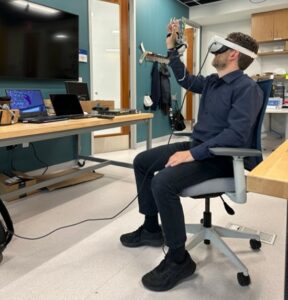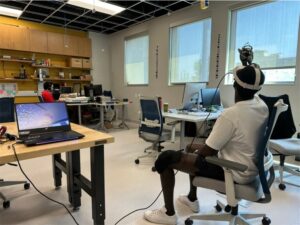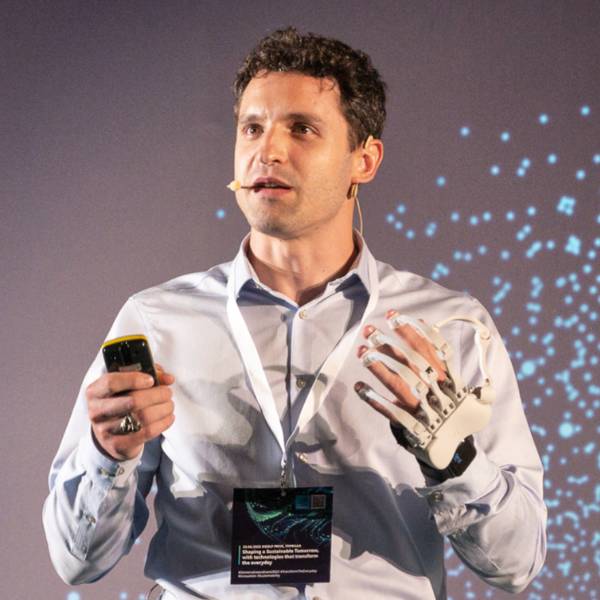Greece
Innovators/Entrepreneurs
Date of the expedition
From June 18th, 2023 to December 18th, 2023
Selected Track
Open Ideas
Project title
Advanced Human Computer Interaction in Virtual Training and Simulation environment
Host Organization
Saint Louis University
Media


On the left picture, you can see Flavio Esposito, Associate Professor in the Computer Science Department. On the right, there’s a photo of a PhD student experimenting with the VR haptic exoskeleton at the PATH Lab, located at Saint Louis University.
Biography
Vasilapostolos Ouranis (aka Vasapo) is the co-founder and Chief Operating Officer of Magos, a role in which he plays a pivotal part in the company’s growth and success.
In addition to his work at Magos, Vasapo is the co-founder of the Greek Newspace Society (GRNSS), a local chapter of the National Space Society (NSS). For nearly three years, he served as Vice President, where he spearheaded numerous programs and initiatives designed to introduce the concept of the “newspace” economy to Greek audiences. His dedication and leadership have been significant in advancing the space industry awareness in Greece.
Before dedicating himself full-time to Magos in 2019, Vasapo gained valuable experience during his four-year tenure at Deloitte, where he served as a Business Technology Consultant. His time at Deloitte honed his expertise in various aspects of business and technology, making him a well-rounded professional.
Project Summary
Purpose:
The project aims to address the limitations of current Virtual Reality (VR) training and education applications, specifically the lack of natural touch interaction in VR environments. While modern VR technology has made significant strides in visual and auditory experiences, tactile feedback remains a challenge. The purpose is to enhance user immersion by introducing a solution that enables natural touch sensations within the virtual world.
Challenge:
The primary challenge is the deficiency in touch feedback provided by current VR controllers, which hinders users’ ability to interact naturally with virtual objects. This limitation impacts the overall effectiveness and immersion of VR training. However, VR training has demonstrated a remarkable 76% increase in learning effectiveness over traditional methods, and it allows employees to be trained four times faster than in conventional classrooms, based on recent surveys.
Target Audiences:
The main target audiences for this project include research centres, medical organizations (clinics), and aerospace companies (for pilot and engineer training). These sectors have a strong interest in improving training and education through immersive VR experiences.
Existing Competitors:
There are some companies, such as haptX, Senseglove, Manus, and TeslaSuit, that are already working on solutions to address the tactile feedback challenge in VR. However, there is still an opportunity for innovation due to existing technology limitations.
Opportunity:
The opportunity arises from the persistent problem of limited touch interaction in VR environments. Current solutions have not fully overcome these technological constraints, leaving room for a ground-breaking solution that can significantly enhance the VR user experience.
VR Haptic Exoskeleton:
Introducing a VR haptic exoskeleton a revolutionary solution designed to bring natural touch sensations into the digital world. The VR haptic exoskeleton achieves this by integrating the complexity of the human hand, allowing users to interact with virtual objects via their fingers, simulating real-life touch experiences. Our solution incorporates three main pillars: Finger tracking, Tactile feedback, and Kinaesthetic feedback, enabling realistic touch simulation.
The solution aims to push the boundaries of realism in VR, further increasing the effectiveness of VR training compared to traditional methods and reducing the required training time. Unlike regular VR controllers, which are often challenging to use and lack realistic interaction, our solution offers a user-friendly, high-performance alternative.
The project is currently focused on enhancing finger tracking accuracy and refining the industrial design of the solution, with plans to launch the first commercial version within the next six months.
Market Potential:
The project seeks to tap into the global VR training and simulation market, which currently accounts for 25% of the VR headset market share, valued at nearly 2 billion euros. Projections indicate that this market is set to grow to almost 25 billion euros by 2026, with a compound annual growth rate (CAGR) of 28%. The goal is to replace conventional VR controllers in this expanding market segment with a revolutionary touch-sensitive solution.
Key Result
The key expected results of the project encompass the development and validation of innovative touch-sensitive VR technologies, strengthened research and innovation collaborations with Saint Louis University, fundraising through equity investment and public proposals in the USA, the establishment of a US branch, and successful engagement with venture capitalists and grant providers. These outcomes collectively aim to propel the project toward market entry, foster growth, and position it as a transformative force in the VR training and simulation industry, ultimately contributing to the project’s success on both technological and financial fronts.
Impact of the Fellowship
By working towards the above-mentioned results, we expect the following impact, as the project will be well-positioned to introduce its innovative VR haptic exoskeleton technology to the market, disrupt the VR training and simulation industry, and drive growth and success in the United States and beyond.
- Technology Testing and Validation: The project will conduct rigorous testing, including demos and pilot programs, to validate the effectiveness and functionality of the developed technologies. This will ensure that the solution meets the highest standards of performance and user experience.
- Scientific Validation: Collaboration with Saint Louis University will facilitate scientific validation of the project’s outcomes and technologies. This validation will contribute to the credibility and acceptance of the innovation within the academic and research communities.
- Strengthened Research Collaboration: The project aims to strengthen research collaboration with Saint Louis University, fostering a productive partnership that can lead to further advancements in VR technology and applications. This collaboration will enhance the knowledge-sharing process and drive ongoing innovation.
- Strengthened Innovation Collaboration: Beyond research, the project seeks to deepen innovation collaboration with Saint Louis University, tapping into the university’s resources and expertise to continually enhance the product and explore new applications.
- Fundraising for Equity Investment: In the United States, the project intends to raise funds through equity investment from angel investors and venture capitalists (VCs). This will provide the necessary capital for scaling up operations, expanding market reach, and further development.
- Startup Establishment: As part of the implementation strategy, the project plans to establish a branch of the company in the US. This physical presence will facilitate closer collaboration with investors, partners, and customers in the American market.
- Attracting Private Investment (VCs): Attracting private investment from VCs is a key outcome, as it not only provides funding but also brings strategic guidance and expertise to help the project navigate the competitive technology landscape.
- Grant Application Success: The project will aim to successfully apply for grants from public and private organizations, securing additional resources to support research, development, and market expansion efforts.

